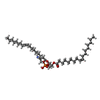+Search query
-Structure paper
| Title | The MscS-like channel YnaI has a gating mechanism based on flexible pore helices. |
|---|---|
| Journal, issue, pages | Proc Natl Acad Sci U S A, Vol. 117, Issue 46, Page 28754-28762, Year 2020 |
| Publish date | Nov 17, 2020 |
 Authors Authors | Vanessa Judith Flegler / Akiko Rasmussen / Shanlin Rao / Na Wu / Renato Zenobi / Mark S P Sansom / Rainer Hedrich / Tim Rasmussen / Bettina Böttcher /    |
| PubMed Abstract | The mechanosensitive channel of small conductance (MscS) is the prototype of an evolutionarily diversified large family that fine-tunes osmoregulation but is likely to fulfill additional functions. ...The mechanosensitive channel of small conductance (MscS) is the prototype of an evolutionarily diversified large family that fine-tunes osmoregulation but is likely to fulfill additional functions. has six osmoprotective paralogs with different numbers of transmembrane helices. These helices are important for gating and sensing in MscS but the role of the additional helices in the paralogs is not understood. The medium-sized channel YnaI was extracted and delivered in native nanodiscs in closed-like and open-like conformations using the copolymer diisobutylene/maleic acid (DIBMA) for structural studies. Here we show by electron cryomicroscopy that YnaI has an extended sensor paddle that during gating relocates relative to the pore concomitant with bending of a GGxGG motif in the pore helices. YnaI is the only one of the six paralogs that has this GGxGG motif allowing the sensor paddle to move outward. Access to the pore is through a vestibule on the cytosolic side that is fenestrated by side portals. In YnaI, these portals are obstructed by aromatic side chains but are still fully hydrated and thus support conductance. For comparison with large-sized channels, we determined the structure of YbiO, which showed larger portals and a wider pore with no GGxGG motif. Further in silico comparison of MscS, YnaI, and YbiO highlighted differences in the hydrophobicity and wettability of their pores and vestibule interiors. Thus, MscS-like channels of different sizes have a common core architecture but show different gating mechanisms and fine-tuned conductive properties. |
 External links External links |  Proc Natl Acad Sci U S A / Proc Natl Acad Sci U S A /  PubMed:33148804 / PubMed:33148804 /  PubMed Central PubMed Central |
| Methods | EM (single particle) |
| Resolution | 3.0 - 4.2 Å |
| Structure data |  EMDB-11556: EMDB-11557, PDB-6zyd:  EMDB-11558:  EMDB-11559: EMDB-11560, PDB-6zye:  EMDB-11561: EMDB-11629, PDB-7a46: |
| Chemicals |  ChemComp-PEE: |
| Source |
|
 Keywords Keywords | MEMBRANE PROTEIN / YnaI small-conductance mechanosensitive channel DIBMALPs / YnaI / small-conductance mechanosensitive channel / DIBMALPs / YbiO / mechanosensitive channel / MscS-like channel / E. coli |
 Movie
Movie Controller
Controller Structure viewers
Structure viewers About Yorodumi Papers
About Yorodumi Papers










